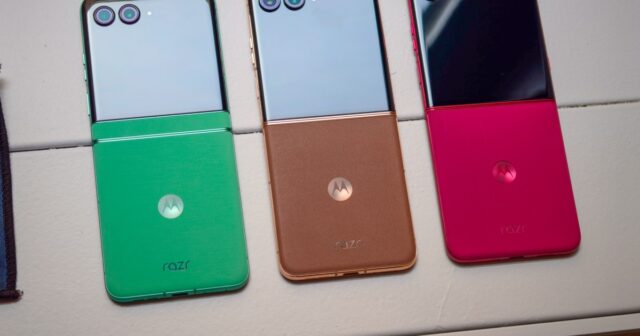If you’ve been looking for a new clamshell phone, chances are that you’ve been considering either the Galaxy Z Flip 6 or Motorola’s Razr lineup. The Razr Plus 2024 was the best flip phone last year, while the Razr 2024 offered a similar experience at a more affordable price. To follow up, this year, Motorola has decided to go one step further.
For the first time, Motorola has launched three new flip phones at varying price points with distinct specifications. The new Razr Ultra 2025 is designed to be the first true flagship flip phone, but the Razr Plus 2025 and Razr 2025 also build on last year’s successful flip phones.
What are the key differences? Do you need the new Razr Ultra 2025, and which one should you buy? Let’s take a look.
Razr Ultra 2025 vs Razr Plus vs Razr 2025: specs
| Moto Razr Ultra 2025 | Moto Razr Plus 2025 | Moto Razr 2025 | |
| Dimensions | Open: 171.5 x 74 x 7.2 mm Closed: 88.1 x 74 x 15.7 mm |
Open: 73.99 x 171.4 x 7.09mm Closed: 73.99 x 88.1 x 15.32mm |
Open: 74 x 171.3 x 7.3 mm Closed: 74 x 88.1 x 15.9 mm |
| Weight | 199 grams | 189 grams | 188 grams |
| Display | Main: 7-inch, foldable pOLED 1224 x 2912 pixels, 464 ppi HDR10+, Dolby Vision, 165Hz 4,500 nits peak brightness Cover Display: |
Main: 6.9-inch, foldable pOLED 1080 x 2640 pixels, 413 ppi HDR10+, Dolby Vision, 165Hz 3,000 nits peak brightness Cover Display: |
Main: 6.9-inch, foldable pOLED 1080 x 2640 pixels, 413 ppi HDR10+, 120Hz 3,000 nits peak brightness Cover Display: |
| Performance | Qualcomm Snapdragon 8 Elite | Qualcomm Snapdragon 8s Gen 3 | MediaTek Dimensity 7400X |
| Storage & Memory | 16GB RAM 512GB / 1TB UFS 4.0 storage |
12GB RAM, 256GB UFS 4.0 storage | 8GB RAM, 256GB UFS 2.2 storage |
| Software | Android 15 | Android 15 | Android 15 |
| Connectivity & Sensors | Wi-FI 7, dual-band / tri-band Bluetooth 5.4, aptX Lossless NFC, USB Type-C 2.0, OTG GPS, GLONASS, BDS, GALILEO, QZSS Side-mounted fingerprint reader |
Wi-FI 7, dual-band / tri-band Bluetooth 5.4, aptX Lossless NFC, USB Type-C 2.0, OTG GPS, GLONASS, BDS, GALILEO, QZSS Side-mounted fingerprint reader |
Wi-FI 6/6e, dual-band / tri-band Bluetooth 5.4 NFC, USB Type-C 2.0 GPS, GLONASS, BDS, GALILEO, QZSS Side-mounted fingerprint reader |
| Battery | 4,700 mAh 68W wired charging 30W wireless charging 5W reverse charging |
4,000 mAh Lithium-Ion 45W wired charging 15W wireless charging 5W reverse charging |
4,500 mAh Lithium-Ion 30W wired charging 15W wireless charging |
| Colors | Pantone (Rio Red, Scarab, Mountain Trail, Cabaret) | Midnight Blue, Hot Pink, Mocha Mousse | Gibraltar Sea, Spring Bud, Lightest Sky, Parfait Pink |
| Price | $1,299.99 | $999.99 | $699.99 |
Razr Ultra 2025 vs Razr Plus vs Razr 2025: design and display
All three phones adhere to the same iconic design language that Motorola has refined and perfected over the past few years, but subtle differences in design and finish ensure they remain distinct from one another.
All three phones feature a large cover display, but the Razr 2025 features a smaller 3.5-inch Cover Display compared to the 4-inch Cover Display on the Razr Ultra 2025 and Razr Plus 2025. Despite the difference in size, the core Cover Display experience remains the same across all three devices. The peak brightness also differs, with the Razr Ultra 2025’s 3,000 nits significantly outperforming the Razr Plus and Razr 2025, which feature peak brightnesses of 2,400 nits and 1,700 nits, respectively.

When you unfold them, the Razr 2025 and Razr Plus 2025 feature the same 6.9-inch main display, with a peak brightness of 3,000 nits, HDR10+ support, and Gorilla Glass protection. The Razr 2025 supports a refresh rate of up to 120Hz, while the Razr Plus 2025 increases this to 165Hz and adds support for Dolby Vision.
Meanwhile, the Razr Ultra 2025 boasts the largest main display on a flip phone, measuring 7 inches, and is equipped with Dolby Vision, Ultra HDR image support, and a refresh rate of up to 165Hz. The peak brightness is also significantly better at up to 4,500 nits.

There are subtle differences between the three devices in size and finish as well. The Razr Ultra 2025 measures 171.5 mm tall, which is 0.1 mm taller than the Razr Plus 2025 and 0.2 mm taller than the Razr 2025. Meanwhile, at 7.2 mm thick, it’s slightly thicker than the Razr Plus 2025 (7.1 mm) but thinner than the Razr 2025 (7.3 mm). While these differences are barely noticeable, the Razr Ultra 2025 is also 10 grams heavier than its siblings, which is a noticeable difference.
All three phones come in a range of finishes (more on that below) and follow the same overall design language, featuring a side-mounted fingerprint sensor beneath the two volume keys on the right side of the phone. The Razr Ultra 2025 also features an AI key on the left, designed to provide quick access to a range of new Moto AI features.
Winner: Moto Razr Ultra 2025, just. If money is no object, the Razr Ultra 2025 has slightly improved specs over its siblings. However, the Razr Plus 2025 is exceptionally compelling, as is the Razr 2025.
Razr Ultra 2025 vs Razr Plus vs Razr 2025: performance and battery

Flip phones face considerable challenges in terms of performance and battery life, especially since the phone maker must also account for two displays. To address these two problems, Motorola built the Razr Ultra 2025, marking the first flip phone to tackle these key issues.
The Razr 2025 is powered by MediaTek’s Dimensity 7400X processor, which is virtually identical to the 7300X processor that powered last year’s Razr 2024, but with a slightly higher clock speed. It’s paired with 8GB of RAM and 256GB of storage. Meanwhile, the Razr Plus 2025 utilizes the same Snapdragon 8s Gen 3 processor as last year’s model, paired with 12GB of RAM and 256GB of storage.
The Razr Ultra 2025 throws the rulebook out of the window and uses the same flagship Snapdragon 8 Elite processor that’s found in many of the best phones. Unlike the super-slim Oppo Find N5, it utilizes the full 8-core version of the processor, paired with 16GB of RAM and either 512GB or 1TB of storage. These are flagship specifications that result in a true flagship experience with far fewer compromises than any other flip phone.

The other key issue with flip phones is their limited battery life, and the Razr Ultra 2025 also addresses this problem. The Razr Plus 2025 features the same 4,000 mAh battery as the Razr Plus 2024, complete with 45W wired charging, 15W wireless charging, and 5W reverse wired charging. Meanwhile, the Razr 2025 features a larger battery than its predecessor, at 4,500 mAh, while retaining the same 30W charging and 15W wireless charging capabilities.
The Razr Ultra 2025 demonstrates that a flip phone doesn’t need to compromise on battery life. The 4,700 mAh battery is the largest in a flip phone to date, but Motorola has also paired it with 68W wired charging, 30W wireless charging, and 5W reverse wired charging. The Razr Ultra 2025 pushes the boundaries of battery and charging, and shows that you don’t need to compromise.
Winner: Razr Ultra 2025. This is no contest; the larger battery, faster charging, and true flagship processor make the Razr Ultra 2025 the one to buy if performance and battery life are your top priorities.
Razr Ultra 2025 vs Razr Plus vs Razr 2025: cameras

Until the Razr Plus 2024, every flip phone followed the same dual-camera setup: a main camera, paired with an ultra-wide. Last year, Motorola decided to drop the ultra-wide in favor of a telephoto camera, meaning you had to determine which was most important to you. This year, Motorola is reversing course, to some extent.
All three phones feature a virtually identical main camera, with Motorola prioritizing consistency across the setup. The Razr 2025 and Razr Plus 2025 feature a 50MP main sensor with an f/1.7 aperture, a 0.8µm pixel size, dual-pixel phase detection autofocus, and optical image stabilization (OIS). The Razr 2025 pairs this with a 13MP ultra-wide sensor, while the Razr Plus pairs this with a 50MP telephoto lens that offers 2x optical zoom.
While those two phones require you to decide which secondary camera lens is more important to you, the Razr Ultra 2025 combines the best of both worlds into a single device. The 50MP main camera is virtually identical to its siblings, but crucially, Motorola achieves the same 2x optical zoom as the Razr Plus 2025 thanks to in-sensor cropping. It pairs this lens with a 50MP ultra-wide sensor, effectively offering a triple-camera setup that’s similar to the one found in many flagship phones.

There are also differences in the camera features, especially as some require the additional power offered by the Snapdragon 8 Elite processor. The Razr Ultra 2025 features several AI-powered features, including Group Shot, which captures multiple frames within a second and blends them to ensure everyone is looking directly at the camera, and Action Shot, which helps you take blur-free photos of moving objects by automatically adjusting the shutter speed based on different lighting conditions. However, it’s unclear whether the Razr Plus 2025 and Razr 2025 will get all of these features or offer fewer features thanks to the limitations of their processors and internal hardware.
Winner: Razr Ultra 2025. Unsurprisingly, the Razr Ultra 2025 offers the least compromises in a flip phone camera to date. Not only does it effectively offer a triple-camera setup, but it also features the full suite of AI-powered camera features.
Razr Ultra 2025 vs Razr Plus vs Razr 2025: software and updates

All three phones run on Android 15, equipped with the same core Motorola software experiences, and come with a promise of three years of software updates and four years of security updates.
They all have the same Cover Display software experience, which allows you to use the front display as a compact phone. New for this year is the ability to add direct shortcuts from the communications panel to features inside a variety of apps, as well as add up to three separate apps and widget panels.
All three also feature the same core Moto AI experience. This includes improved versions of the first-generation Moto AI experiences, including Catch Me Up to summarize personal notifications, Pay Attention to start a voice recording complete with transcription, and Remember This to save a screenshot with notes and quickly recall it later.

They also come equipped with Moto AI 2.0, which includes the Next Move feature. This feature analyzes what’s on screen and recommends next steps, such as saving important information, creating a playlist in Playlist Studio, or generating an image, sticker, or avatar in Image Studio. All three feature Gemini and Gemini Live directly from the Cover Display and come with both Perplexity Pro and Microsoft CoPilot preloaded out of the box.
The Razr Ultra 2025 features a dedicated AI key to launch Moto AI from anywhere, as well as a new hands-free mode. When you place the Razr Ultra 2025 in stand or tent mode — i.e., when the phone is half folded — you can glance at the screen and use Moto AI features without needing to touch the screen.
Winner: Tie. Yes, the Razr Ultra 2025 features a dedicated AI key and one exclusive Moto AI feature, and the more powerful processor ensures it’ll run Moto AI far smoother than its siblings. However, all three phones offer the same overall experience.
Razr Ultra 2025 vs Razr Plus vs Razr 2025: price and availability

The most noticeable differences between the three devices are the choice of Razr 2025 colors and finishes, as well as the price tag associated with all three phones.
The Razr 2025 starts at $699.99 and is available in a choice of four finishes: Gibraltar Sea (navy blue), Lightest Sky (white), Parfait Pink, and Spring Bud (light green). Meanwhile, the Razr Plus 2025 starts at $999.99 and comes in the same colors and leather-backed finish as last year’s model: Midnight Blue, Hot Pink, and Pantone Color of the Year, Mocha Mousse.






The most unique is the Razr Ultra 2025, which starts at $1,299.99 and has a choice of four distinct finishes. The Scarab model features Italian Alcanatara leather for the first time on a smartphone. The Rio Red and Cabaret (pink) models feature the same leather-like finish introduced last year. The most unique finish is the Mountain Trail, which features an FSC-certified wood finish, marking the first time Motorola has used wood in a phone in over a decade.
Should you buy the Razr Ultra 2025, Razr Plus 2025, or Razr 2025?

The Razr Ultra 2025 proves that you can have a flip phone that does it al,l but this comes at a price: $300 more than the Razr Plus 2025, to be precise. For this, you get a vastly improved overall experience that’s designed to address all the key flaws of a flip phone. While it’s the most expensive overall, the Razr Ultra 2025 is also the most capable and almost certainly the best flip phone you can buy.
However, the price tag also means it won’t work for everyone, and this is where it gets murkier. The Razr 2025 appears to be an outstanding device, offering a compelling experience at half the price of the Razr Ultra 2025. Yet, the Razr Plus 2024 is identical to this year’s Razr Plus 2025, and currently costs just $799.99, making it arguably the better choice. That said, whichever Razr 2025 model you buy, you’ll get the most refined flip phone experience.

















































